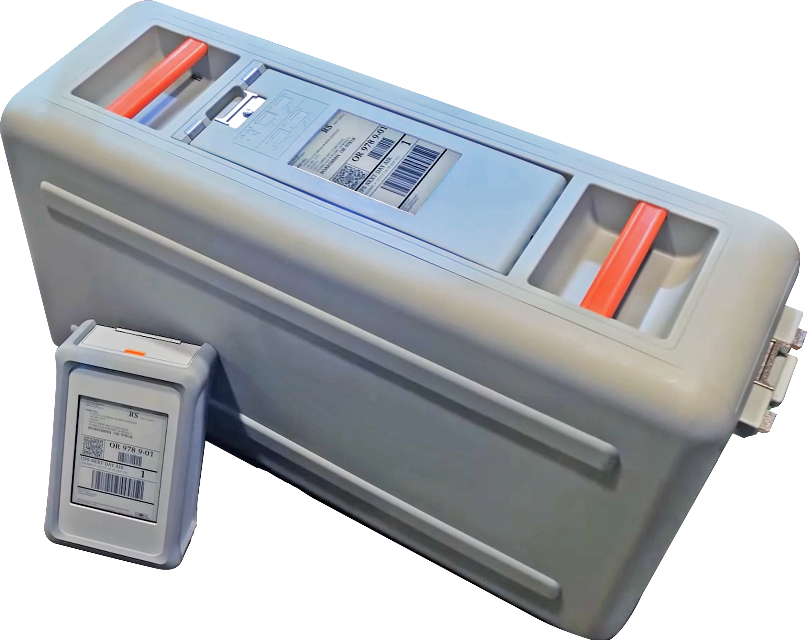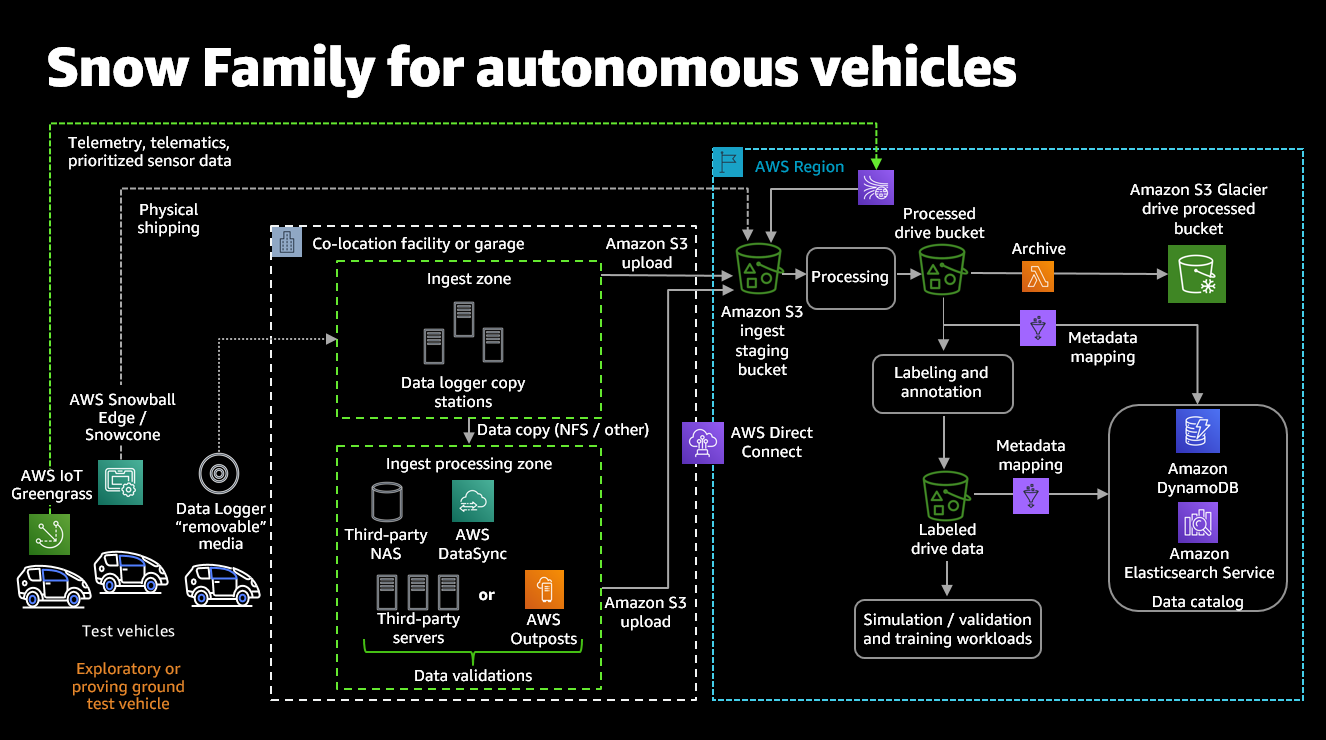AWS Storage Blog
AWS re:Invent recap: Edge computing innovation with the AWS Snow Family
Ramesh Kumar, Senior Product Manager of the AWS Snow Family, just broadcasted his AWS re:Invent 2020-2021 session yesterday: “Edge computing innovation with AWS Snowcone and AWS Snowball Edge.” You can now watch Ramesh’s 30-minute edge session on-demand. In this blog, I discuss highlights from Ramesh’s session, including an overview of AWS services from the cloud to the edge and an overview of the AWS Snow Family. I also cover common customer workflows discussed, including IoT use cases in a factory, IoT use cases in healthcare, private LTE/5G wireless networks, and data ingest for autonomous vehicles.
Ramesh also had a session a few days ago focused on optimizing your data migration with AWS Snowcone and AWS Snowball Edge. You can view that on-demand session in addition to the companion blog recap, but today I am going to talk about another prominent Snow use case — edge computing.
Edge location challenges
Running applications from AWS Regions is ideal for most workloads, but for those who contend with low latency or data residency constraints, the AWS Edge portfolio is ideally suited. The AWS Edge portfolio includes AWS Snow Family, AWS Wavelength, AWS Local Zones, AWS Outposts, AWS Storage Gateway, AWS IoT services, along with a few additional services.
Issues such as network connectivity, bandwidth costs from transferring massive amounts of data, and local rules or regulations can sometimes affect or discourage public cloud adoption. Some of these edge locations require the ability to operate independent from an AWS Region with intermittent connectivity, low bandwidth, or even fully disconnected. Examples shared by our customers include IoT hubs to capture and process sensor data, image processing, video analytics, and machine learning inference models for local data. Snow devices help customers that must run operations in austere, non-data center environments, and in locations where there is a lack of consistent network connectivity.

AWS Snow Family
Ramesh examined how the AWS Snow Family’s various form factors, compute/storage capacities, and supporting services are ideally suited to meet unique edge workload and deployment requirements.

AWS Snowcone is roughly the size of a tissue box and is ultra-portable at just 4.5 pounds (2.1 kg). AWS designed the device to meet stringent standards for ruggedization for use in harsh conditions, including humid or dust-prone environments. Its small footprint and light weight makes it ideal for deployment in vehicles, backpacks, or drone use cases. AWS Snowcone can be used for local compute with its 2 vCPUs and 4 GiB of memory, offline data migration jobs, or by leveraging AWS DataSync to transfer data online. If desired, it can even be battery powered to increase its range!
AWS Snowball Edge comes in a slightly larger form factor to house additional compute and storage capacity and is available in two options — Compute Optimized and Storage Optimized. With AWS Snowball Edge specifications supporting 24–52 vCPUs, 32–208 GiB of memory, 42–100 TB of storage plus 1–7.68 TB of additional SSD storage for block volumes, they are exceptionally versatile. You can even order AWS Snowball Edge with a GPU. You can use it for machine learning inference at the edge or for creating object storage clusters with multiple devices for support of greater than 1 PB of local storage.
Customers familiar with deploying workloads in-Region will find it easy to run compute on a Snow device. Simply develop the application in the Region, validate/test the stack, and deploy the Amazon Machine Image (AMI) when placing a Snow job. The documentation on how AWS Snowball Edge works provides step-by-step instructions to prepare and place a Snow job when you are ready to give it a try.
This year, AWS released several significant enhancements to the Snow Family, including support for Windows operating systems on Snowball Edge and the ability to import Amazon Machine Images (AMIs) after a device is deployed. Managing Snow devices got even more convenient with the introduction of AWS OpsHub. AWS OpsHub is a user interface that provides setup, configuration, and unlocking capabilities for multiple Snow devices from the local area network. Customers familiar with the command line Snowball client tools will find that AWS OpsHub makes managing Amazon EC2 instances and file transfers incredibly convenient.
AWS OpsHub is available for download directly from the AWS Snowball resource page and can be installed on any Windows or Mac, such as a laptop. It supports Snowcone, Snowball Edge Storage Optimized, and Snowball Edge Compute Optimized devices and is available globally where these devices are available, at no extra charge.
Enabling customer edge computing workflows
AWS users have discovered many use cases ideally suited for the AWS Snow Family. These use cases include IoT for manufacturing and healthcare, private LTE/5G network deployments, and even data gravity needs like autonomous vehicle fleets.
Environments with insufficient internet connectivity, such as factory floors, are leveraging Snow devices to collect and process sensor and machine data from equipment such as robots or automated assembly lines. Customers can run machine learning (ML) inference on collected data by running their Amazon SageMaker Neo optimized ML inference models on Snow devices. This enables customers to avoid unforeseen failures that interrupt their production lines that ultimately cost time and money.

Oftentimes, these types of manufacturing deployments have space constraints prohibiting local infrastructure. You can use Snow devices to run edge computing in a disconnected manner. While doing so, you can provide Amazon EC2 and Amazon EBS volumes to enable a consistent programming and DevOps model to test in the cloud and run at the edge.

Snowcone can also be used for data collection and processing in healthcare facilities such as hospitals, doctor offices, and in emergency relief scenarios. This creates an amazing opportunity for humanitarian efforts during natural disasters or by traveling healthcare professionals sent to remote field locations. Leveraging IoT, healthcare practitioners are capturing medical instrumentation data and processing it in real time locally without the need for large racks of infrastructure or internet connectivity.

Solution highlighting a connected model deployment with mobile core facilitated by AWS Snowcone
Many enterprises are deploying private LTE/5G wireless networks rather than Wi-Fi networks. Doing so enables them to reap the benefits of higher security, less interference, and the ability to manage the quality of service to the subscriber device. Comprised of a radio network, core network, transport network, internet connectivity, spectrum management, network management, subscriber devices, and SIM cards, private LTE/5G networks are complex to implement and establish. They provide coverage to college campuses, school districts, athletic stadiums, and retail establishments. These types of deployments commonly require weeks of planning and implementation. By utilizing AWS Snowcone indoor or outdoor to automate the network installation, it is possible to streamline a deployment to as little as a week. For a related higher education use case, see the blog post on intelligent video analytics and effective remote learning on campus private 4G/5G networks.
AWS Snowcone can provide up to 150 Mbps network capacity by running the user plane locally with the control plan residing in an AWS Region. For private mobile network deployments to oil rigs, mines, refineries, and rural coverage, both the user plane and control plan reside locally to support up to 100 Mbps network capacity.

Example architecture illustrating how the AWS Snow Family combined with regional AWS services can facilitate data migration and analysis of autonomous vehicle fleets
The Snow Family helps automotive customers make it easier and faster to migrate hundreds of terabytes per day from their fleets of autonomous vehicles. Generating up to 40 TB of data daily and with fleets of 10s-100s of test vehicles, fleet managers have challenges pulling sensor data from lidar, radar, or video cameras for analysis. They must retrieve data from the local data stored in the vehicles and then transfer, transform, and analyze that data rapidly at a staggering scale. By transferring this data to AWS Snowball Edge, customers can offload the testing vehicle telemetry and easily import data into AWS in a matter of days.
Final thoughts
AWS Snowball Edge and AWS Snowcone are fueling innovative edge deployments in diverse sectors across both commercial and public sector organizations. Factory floors, hospitals, athletic stadiums, college campuses, and retailers are leveraging Snow devices to overcome traditional edge location challenges. It is exciting to review some of the new Snow enhancements released in 2020 and I am looking forward to seeing what 2021 brings for compute at the edge.
Be sure to check out the session on-demand for the full presentation and further learn how the AWS Snow Family can enable your edge computing innovation needs.
I hope you enjoyed Ramesh’s session along with the takeaways from the session that I featured in this blog. If you have any comments or questions about this re:Invent session or this blog post, please don’t hesitate to reply in the comments section. Thanks for reading!
For more information on any of these topics, check out the following resources:
